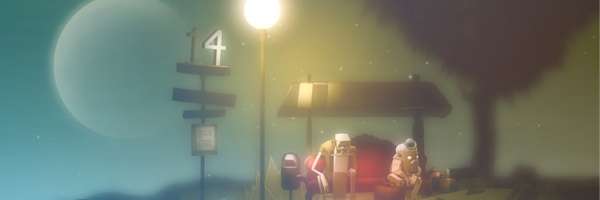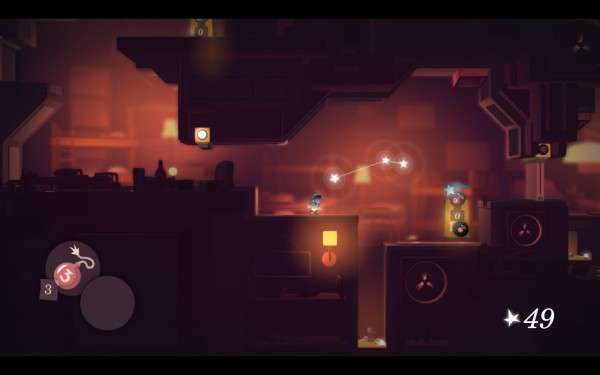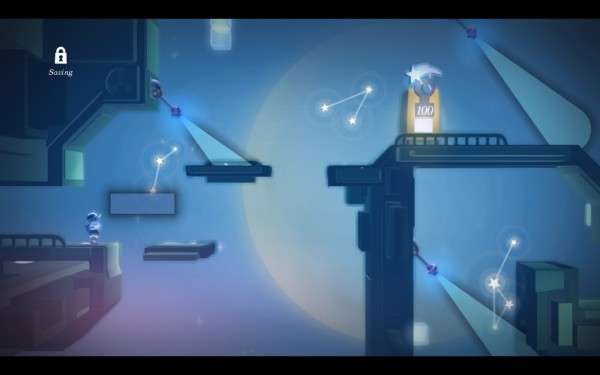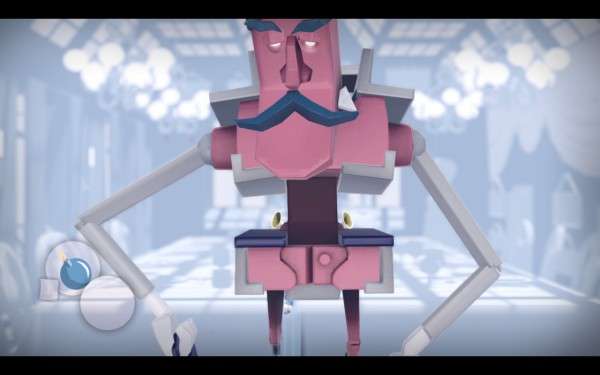
Pid Mac Review
Pid is a wonderfully strange and quaint game, coming from the Scandinavian mind hive of Might and Delight, and a debut that takes many of its cues for its gameplay from old-school platformers such as Mega Man and Bionic Commando. Pid really endears itself to the nostalgic gamer with a soft spot for beautiful visual fidelity, with the addition of gameplay that will delight and infuriate all at the same time. But putting that aesthetic quality aside, does the experience illuminate the mood, or does it merely divert from what could be a whimsical experience?
Pid begins with you playing the young boy, Kurt, who has just woken up on a strange planet after missing his bus stop whilst on an intergalactic school trip. Having to make his way home without use of transportation – which has been conveniently shut down – Kurt must make his way through various locales, which include a castle, a city, an attic and a space station, to find his way home. Things, however, are not so simple. There is a conspiracy of sorts afoot and Kurt is tasked with finding out what is happening on the planet, who is hunting him and why the ruler will not allow anyone to leave.

Coming from some of the team (formerly of GRIN) that had previously worked on the excellent Bionic Commando: Rearmed, Pid hearkens back to the old-school days of the platform genre – that’s not necessarily a good thing, either. The controls at times can be rather sluggish, with Kurt not jumping when requested, resulting in many falls to death or countless boss battle restarts. Pid‘s controls will frustrate and at times make you put the pad down and take a break. Thankfully, the game does, however, frequently save – usually with each new screen – so you have a quick-start should anything tragic befall you, as is often the case.
Once you get used to the responsive quirks of the controls, traversal can be quite a fun endeavour. Whether jumping from platform to platform, floating along one of the light illuminated gravity wells, or even collecting the glittering array of star constellations, movement isn’t perfect. But you get used to it, to a degree.

You will find yourself repeatedly annoyed by the often unresponsive input when it comes to the game’s larger-than-life (and clearly Bionic Commando: Rearmed-inspired) bosses, however, each an exercise in patience and often in frustration. Meet the Butler, a flying robot headed waiter and the first boss, who is a quite simple one to beat when you break down the process, but to actually do so successfully is an infuriating and often perplexing endeavour. You start this battle by smashing some plates on the table, in response to which the Butler turns around and flies in your direction. A huge hulking beast, the Butler then initiates a clean-up sequence and you are tasked with finding and hitting his weak spots. However, if you are hit just once, you have to start the whole process again. If this was a short, two-minute battle it wouldn’t seem quite so antagonising, but when the battle itself lasts around 5 minutes, combined with the control battles, it quickly adds up. Trial and error is a punishment in this game and the added control woes really grate on the experience at times.
Moving on from the boss battles, without a doubt, the puzzles are the finest part of the game, requiring clever use of the beams to bypass rockets, spiked pits or merely to gain access to an otherwise out of reach platform. Early into the game, Kurt comes across an orb that gives him the ability to throw two beams of light at any one time. These beams of light create gravity wells, and allow Kurt and certain objects and enemies to float within its beam of light. Drop a beam and you will float; throw one at the walls and you will traverse through the air – even when thrown at a diagonal surface you will float at a 45º angle. You can also use these beams to temporarily move security cameras. Think of the Excursion Funnel beams in Portal 2 and you’re part of the way there. This ability allows you to traverse the areas that you come across in a variety of ways, and in doing so, helps Kurt to continue his journey. Later in the game, new abilities are unlocked. These range from anti-gravity boots to bombs, laser beams and many more, all unlocking different methods with which to traverse the levels.

I found myself wishing the game focused more on this aspect and the inclusion of an involving story rather than forcing a boss battle with little-to-no exposition. It seems the goal is making it to the end of the levels, and subsequently the story. I do wish more time was spent on finding out more about the character. Sadly, this is not the case. We learn little about Kurt, and who the seemingly-ineffectual robots are until its too late to make an impact on the player.
You are stalked throughout the game by robots – a variety of looming, mechanised figures who try to stop your journey and retrieve the gem. These robots are rightly to be feared – with a single touch or even if you are seen, it’s back to the previous checkpoint. This is where use of the gem comes in handy, enabling you to manoeuvre your way around the vision cones of the enemies using the instantaneous gravity wells the gem’s ability blesses you with.

There are also times where you will wish there was more visual feedback, or at least a vague notification of where you must go. An example of this being a moment when I had to make my way (in any order) through one of four doors and traverse through various traps and puzzles. The aim of each of these “trips” was to collect the four limbs to enable a woman to help your progress. Whilst I did not have any problems whatsoever with this set fetch quest, what I was baffled by was at the end of each of these routes (which always came back on itself, may I add), I possessed one of each of these limbs, yet I had no idea how I had acquired them. There was no acknowledgement, nor a notification to tell me that I’d managed to collect anything.
Pid is a game light on guidance, but heavily-based on its visual feedback, which in itself is a perplexing conundrum at times. It’s almost as if the developers themselves were so taken in by the visual feast they had produced, that they had neglected to inform the player of which route to take next.

Visually speaking, however, Pid is a beautiful game and a testament to the artists and level designers at Might and Delight. The opening is a wonderfully-fitting and endearing introduction to the planet – quirky, smirk-inducing and easy on the eye, all at the same time, like a cacophony of visual wonderment, combined with a striking pastel excess. This is a seriously good-looking game and one that manages to whiz along without much slowdown, even on my four-year-old MacBook. The art style is immediately striking and throughout the entirety of your adventure you can’t help but admire the presentation, from the backstreets clearly-inspired by European architecture, to the enemies which are inspired spins on recognisable machinery such as lawnmowers, leaf blowers and other various machinations. The city level in particular is a personal standout point for me. Although seemingly sedate and stationary due to the lack of transportation, it maintains a certain vibrancy and ardour about it, which had me tapping the Screenshot Grab button frequently throughout the entirety of the level.
The soundtrack of the game, a play on rock- and jazz-infused melodies composed by the Retro Family (a trio of Swedish musicians), creates quite a jaunty tone to affairs without being anything memorable. At times, the audio can grate – especially when having to replay an already-annoying boss battle, the soundtrack just adds to the irritation. But for the most part the audio as a whole is simple and effective, without being too intrusive.

The game comes in two flavours: single-player and co-op. Single-player is pretty self-explanatory, while co-op allows you and one other player (who plays as a character named Audrey) to work together through the levels. Co-op play relies on trust and patience as each player has the ability to throw a single beam (rather than the two beams that can be cast in single-player), and in doing so, you must both help (or hinder) each other’s progress. Sadly, co-op is local play only, but this only adds to the tension as you berate your partner for screwing up progression again.
Normal Mode is the hardest available difficulty at the beginning of the game and will provide enough of a challenge for most players, with a Hard Mode being unlocked after completion of the game. Collectables in the form of (often expired) ticket stubs are littered around the levels in various hard-to-reach places and will require much patience and perseverance to get there, providing ample opportunity for replayability once completed.

Overall, as a gaming experience, Pid is a tough, quirky and unapologetic platform game, which really excels when you are tasked with solving the game’s charming puzzles. Sadly, as a whole it is one that overall creates a “meh” factor to many who will see past its visual charm, with irritating boss battles, unresponsive and, at times, unforgiving gameplay. At moments, Pid is frustrating, then good, and sometimes threatening to be really good. I wish I could spend more time just watching the wonderful vistas being presented than having to play, and that is where the problem lies, ultimately. Simply put, it’s a surprisingly lengthy, old-school gaming experience with a visual charm that deserves to be seen and experienced by possessors of great patience and lovers of the platform genre. An intriguing debut for a few reasons, I look forward to what else the intriguing minds at Might and Delight can conjure up.
